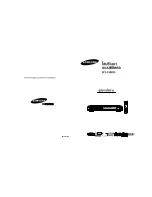
Vr1
Replacement Brake Adjuster
Kit Fitting Instructions
Britpart, The Grove, Craven Arms, Shropshire, SY7 8DA United Kingdom
Tel: +44 (0) 1588 672711 Fax: +44 (0) 1588 672660
Email: [email protected] www.britpart.co.uk
Part Number
RTC3176
MPK 1, 2, 3 & 4
Instructions (Eccentric type only)
1. ‘On the vehicle’ repairs can be best attempted by tilting
the front wheels as high as possible before removing road
wheels and brake drums. This initial positioning of the vehicle
will eliminate unnecessary cramped working conditions and
allow accurate adjuster replacement.
2. After ensuring that vehicle is properly supported,
handbrake and wheel chocks applied, remove road wheel(s)
and brake drum(s).
3. Carefully remove brake shoes and springs (noting the
relative position of all items removed to aid reassembly) and
wire up brake cylinder pistons.
4. Use small brush and vacuum cleaner to remove asbestos
dust from all areas of backplate.
WARNING
DO NOT ATTEMPT TO BLOW DUST OFF BACKPLATE.
INHALED ASBESTOS DUST CAN BE HARMFUL TO HEALTH
5. Hacksaw off as much of the old adjuster as possible,
taking care not to damage the backplate or wheel cylinders
in the process.
6. Using a centrepunch, mark the precise centre of the
remaining part of the adjuster and drill through using
1
/
4
and
3
/
4
dia drills taking care not to damage the backplate.
Finally remove the old adjusters with a sharp chisel.
7. After removal of the old adjusters, clean areas around
holes in backplate on both sides, removing all traces of
corrosion and any burred edges so that the backplate is
smooth and flat. Make sure that the backplate in also free
from saw and drill swarf. THE BACKPLATE IS NOW READY
FOR INSERTION OF THE NEW ADJUSTERS.
GAUGING
8a. Using up to a maximum of three shim washers (4) space
the lock ring through the backplate (3) so that the inside
face of the lock ring (5) is flush or slightly below the inside of
the inside face of the backplate (3).
N.B. It may only be necessary to use two shim washers (4)
although, dependant on backplate (3) thickness, it is possible
for no shim washers (4) to be required at all at this stage.
IMPORTANT
8b. If when using the maximum of three shim washers (4)
the inside face of the lock ring (5) is still proud of the
backplate (3) it will be necessary to file off any excess from
the face of the lock ring (5) (with the three shim washers in
position) until the flush condition is achieved.
9. When the correct number of shim washers has been
determined (this may differ between adjusters on the same
backplate) ADD ONE MORE SHIM WASHER to this number
and loosely assemble the complete adjuster through the
backplate.
10. Ensure that the Belleville washer (2) is assembled. Place
a
1
/
4
square brake adjuster spanner on the new peg, and
ensuring that the lock ring (5) has entered cleanly through
the shim washers (4) and the hole in the backplate (3) begin
to tighten the lock nut (6) with
9
/
16
A/F spanner. This will
drive the lock ring onto the splines of the brake adjustor
body and flatten the Belleville washer against the backplate.
N.B. When the job is being tackled ‘on the vehicle’ there may
be some instances where it is difficult to use the spanners
as directed above. In these cases it is permissible to grip the
adjuster body (not the peg) on the brake drum side to
prevent turning whilst tightening the locknut.
IMPORTANT
Make sure the brake adjuster body is clear of turning stop in
the backplate when tightening lock-nut.
11. Continue to tighten locknut until a stiffness of 2-3 lb ft
torque is required to turn new brake adjuster, smoothly, in
backplate with a
1
/
4
square brake adjusting spanner. 2-3 lb
ft torque is approx, equivalent to a spring balance reading of
between 4 and 6 lb when hooked through the loose end of
brake adjuster spanner.
New brake adjuster is now fitted.
12. Repeat operations on remaining adjusters.
13. Reassemble brake shoes and springs (remembering to
remove lock wire from, brake cylinder pistons) and replace
brake drums. Adjust brakes.
14. Replace road wheels and road test. Make further
adjustments as necessary
N.B Please read through instructions before commencing work on vehicle. Always use the correct
spanners, otherwise ‘rounding off’ of the adjuster peg will result.
List of items required:
1
/
4
square brake adjusting spanner; Hammer; Small sharp chisel; Electric drill and
1
/
4
and
3
/
4
dia drills
(sharp);
9
/
16
A/F combination spanner; Centrepunch; Hacksaw; Wheel nut spanner; Posidrive screwdriver;
Ramps or jacks; Wheel chocks; Vacuum cleaner; Small brush; Clean wiper




















